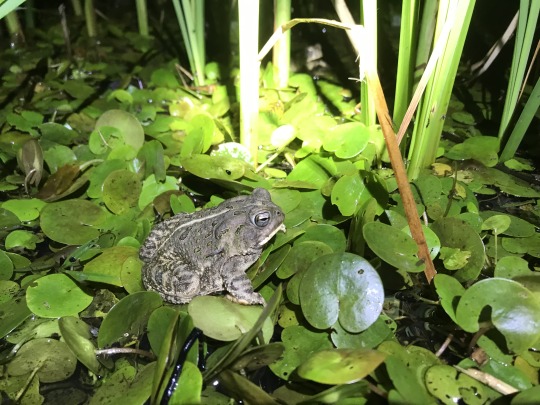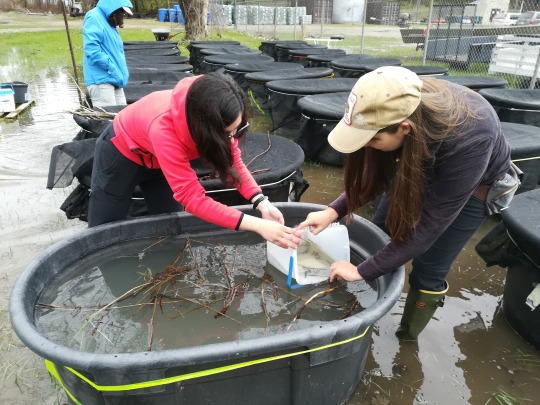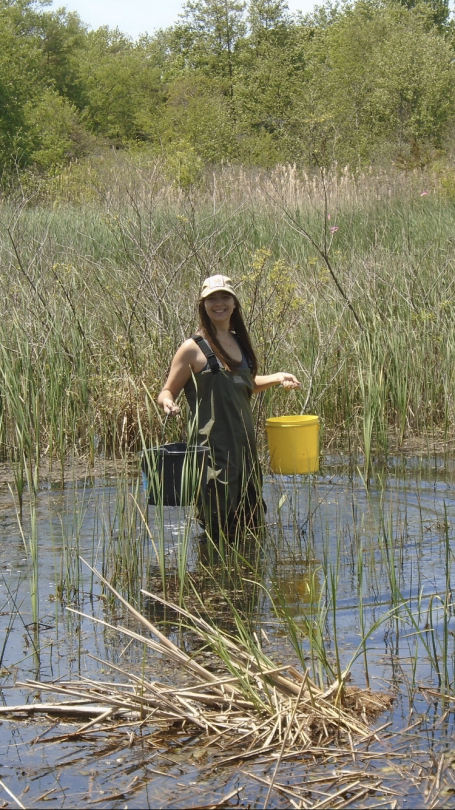by Jessica Ford

I’ve been doing field work in Long Point, Ontario for the last 3 years to study American toad and Fowler’s toad tadpoles. It is a beautiful sand spit on the Northern shore of Lake Erie with a remarkable amount of biodiversity for Canada. We often find several species of turtles, snakes and frogs while on our nightly treks to look for toads. As a child I loved playing in the mud, now that is what I do for my research, as I wade through swamps looking for breeding toads so I can bring their eggs back to my mesocosms.
Long Point is a very dynamic system. The lake can change the shape of the point, the size of the beach, and the slope of the dunes in a single storm. The graduate students who preceded me used to wear boots in parts of the swamp that are now too deep to enter without waders. Trees that used to mark field sites have since fallen into the lake as the dune under them eroded away. The Fowler’s toads are sand marsh specialists, they are used to this dynamic system, but in the summer of 2019, we experienced a field season more unpredictable than any of us, and maybe even the toads, had ever seen before.
We arrived in Long Point the same day that my supervisor and students have for the past 32 years: May 1st. We could hear the American toads calling from the marsh near the field house, a welcome sound after a day of driving. The next morning, we eagerly piled into the field minivan (glamorous, I know) to drive to the beach and see how the dunes changed over the winter. We walked down our regular path to the beach, and at the end of the path we looked down. This was new, this path used to be flat, but now ended in a cliff with nothing but a thin patch of beach underneath. “Well” I told the volunteers “that patch of the field site is gone!” We thought it would be a funny story to tell my supervisor about how drastically the site had changed, we took some fun pictures to show how high the cliff was, we laughed about it on the way to the next area of beach. We thought this was unique to this area. We were wrong.

A normal night during the Long Point field season consists of corralling the volunteers into reflective vests and headlamps and hiking along 7 km of marsh and beach to look and listen for toads from 10 pm onwards. We catch all the toads. If we hear one calling, we wade into the marsh, following the sound of a distressed sheep (the lovely noise Fowler’s toads make to attract a mate) until we find the calling individual. If we spot one on the beach, we pick it up. We take pictures of all these toads to identify them later, as the wart pattern on their back acts like a fingerprint and remains the same their whole life. This nightly population survey has been ongoing for over 30 years. In order to complete it, we need to walk the beach.
There was no beach.

There was also no path to the beach, either. The path we had walked since I had begun my field work here was now under water. Parts were too deep even for our waders. We made a new path, but the lake was not done with us yet, and soon that disappeared as well. We tried completing the area of the survey anyways, maneuvering through the marsh, but we soon called it off. It wasn’t so much the lack of beach, or the lack of path, or the inaccessibility that caused us to change course. No, it was the lack of toads.
Now it is not abnormal in these past years for there to be no Fowler’s toads when we arrive in Long Point. They tend to breed about two weeks later than the American toads do. But those two weeks had passed, and we hadn’t heard a single Fowler’s toad call. We continued to search along the remaining patch of beach every night, finding all sorts of critters, but no Fowler’s toads.
Finally, on the night of May 18th while driving to the beach, I heard a familiar sound. It was a high pitch wail reminiscent of a screaming child, or a distressed sheep, or a grad student whose research isn’t going well – our beloved Fowler’s toad. He was calling from a marsh on the side of the road. We pulled over, leapt out, and scooped up our little singing man. We named him Jesus, the savior of the toads. Surely, more would emerge now and start singing. Females would hear them and come to breed in the marshes and ponds. Our hope was renewed!

We found Jesus the toad several more times, singing from his favorite spot, but he was always alone. Eventually, we found 3 additional males, singing from flooded paths and a trailer park, but there were no females, and they never grouped together into a chorus.
Now, if you recall, I study tadpoles. In order to study tadpoles, I need breeding toads. I had American toad eggs, but to complete my experiment needed Fowler’s toad eggs as well. The window to stock my mesocosm with tadpoles was shortening, I would have to start gathering samples soon. The Fowler’s toads are endangered, we knew there was a possibility that there could be a season they did not breed. I had a backup plan: stock all the mesocosms with American toad tadpoles instead. Another week passed with no sign of successful Fowler’s toad breeding, and I made the call to use all American toad tadpoles in my experiment.

More time passed, there were still only 4 toads. Was this it? Was this the only population that was left? Were there no female Fowler’s toads in all of Long Point, only these 4, distant, lonely males?
We began growing ever more desperate, and began to panic a little that perhaps this was the year that the Fowler’s toads would be extirpated from Long Point. 32 years of research, come to an end, from habitat loss due to high water, invasive phragmites, eroding dunes, and a lack of suitable breeding sites. I study the ecological consequences of tadpole loss, but that is a mesocosm experiment, I did not want it to become a reality. We set a date: May 25th, Panic Day. According to our field notes, May 25th was the latest day that the Fowler’s toads had ever emerged from hibernation, and that was the year it snowed in May. We agreed to maintain high spirits until Panic Day, and if there were no additional toads by then, then we could panic.
The weeks leading up to May 25th only served to fill us with more despair. The water was rising with no sign of receding, despite the weather report claiming it would any day now. It got so high that our minivan, lovingly coined the toad mobile, could not pass through some areas of the road that had been flooded. This meant that we couldn’t access our field sites, or my tadpole filled mesocosms, some days. We tried to use these days as days off, and I spent one of them wandering through the wetland near the field house, looking for whatever herps I could find to cheer me up. I spotted a turtle, oh joy! But on closer inspection it was dead. I spotted several more, some painted turtles and even some large snapping turtles: dead. Some of the locals had been noticing this too, which prompted an investigation from the turtle researchers. The dead turtles tested positive for Ranavirus, an incurable, deadly disease that can affect amphibians, reptiles, and fish, often leading to mass mortalities. This was crushing news. The researchers in Long Point who studied turtles and snakes were beginning to panic too now, it wasn’t just our toads, there were many species that were missing.
May 25th came, there had been no additional toads. This, combined with the news of the Ranavirus outbreak and the missing reptiles, made the stakes feel extremely high driving to the beach that night. We all needed some good news. “Even just one toad” I thought “just give me one toad on the beach, one little beacon of hope”.
We were all jumpy that night. We hurried over to every toad shaped rock, toad shaped leaf, toad shaped pile of sand, anything that could, maybe, be a sign that there are more toads emerging. No luck. But then, in the distance, I saw the two little green, shining dots. They looked like eye shine, but too large to be from a spider, and they were peering straight back at me. The volunteers saw it too, and we all started walking faster, eager to see if this could be what we were hoping so much to see. We got closer, the silhouette of a toad was apparent. It was a fat, round little creature, staring at these massive mammals with bright headlamps rushing towards it blankly. “This toad is an idiot” I thought “but could it be one of our little idiots?”
It was! At long last, and right on time, a Fowler’s toad on the beach! Right where they are supposed to be! Over the next week more toads emerged, late, but here. Some even bred! We rescued their eggs from the puddle in a parking lot where they were laid, a poor decision on the toads’ part. One toad named Tiny Tim even bred three times, producing one successful clutch, and we declared him the most eligible bachelor in Long Point. I raised these Fowler’s toad tadpoles in floating pens since the mesocosms were full, keeping them safe from predators and monitoring them.
The rest of the summer was filled with more challenges. The ponds and the marsh went hypoxic, but some of the tadpoles we rescued survived. There were more causalities of the Ranavirus, but the remaining turtles were healthy and even reproduced. We thought the dunes, which were difficult for us to climb, would be impossible for a toad, but found some halfway up it anyways. The provincial park closed due to flooding, but this created some great habitat for the toads. I released over a thousand little toadlets, who will hopefully survive the winter and become part of next year’s population, eventually producing little tadpoles of their own.

This winter, the news reports for Long Point include such lines as “you wouldn’t believe there used to be land here”. The lake never did go down, in fact Lake Erie only rose more, breaking all its records. I don’t know what I’ll be walking into in May this time, but the toads have surprised me before, and I hope they will again. To quote Dr. Ian Malcom in Jurassic Park: “life, uh, finds a way”.

Jessica Ford is a PhD student in the Green lab in the Redpath Museum of McGill University. She studies the ecological consequences of tadpole loss using toad tadpoles in experimental mesocosms. She also raises these toad tadpoles to release them as toadlets to help boost local populations.

0 Comments